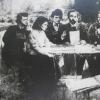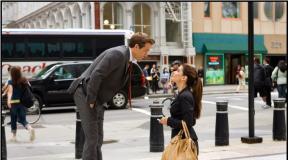Conditions necessary for the existence of electric current. Conditions for the existence of electric current. Parallel connection of current sources
Electric current is the directionally ordered movement of electric charges. The direction of current is taken to be the direction of movement of positive charges.
The passage of current through a conductor is accompanied by the following actions:
* magnetic (observed in all conductors)
* thermal (observed in all conductors except superconductors)
* chemical (observed in electrolytes).
For the occurrence and maintenance of current in any environment, two conditions must be met:
* presence of free electric charges in the environment
* creation of an electric field in the environment.
An electric field in a medium is necessary to create directional movement of free charges. As is known, a charge q in an electric field of intensity E is acted upon by a force F = q* E, which causes free charges to move in the direction of the electric field. A sign of the existence of an electric field in a conductor is the presence of a non-zero potential difference between any two points of the conductor,
However, electrical forces cannot maintain an electric current for a long time. The directed movement of electric charges after some time leads to equalization of potentials at the ends of the conductor and, consequently, to the disappearance of the electric field in it.
To maintain current in an electrical circuit, charges must be subject to forces of a non-electrical nature (external forces) in addition to Coulomb forces.
A device that creates external forces, maintains a potential difference in a circuit and converts various types of energy into electrical energy is called a current source.
For the existence of electric current in a closed circuit, it is necessary to include a current source in it.
Main characteristics
1. Current strength - I, unit of measurement - 1 A (Ampere).
Current strength is a quantity equal to the charge flowing through the cross section of a conductor per unit time.
I = Dq/Dt.
The formula is valid for direct current, in which the current strength and its direction do not change over time. If the strength of the current and its direction change over time, then such a current is called alternating.
For AC:
I = lim Dq/Dt ,
Dt - 0
those. I = q", where q" is the time derivative of the charge.
2. Current density - j, unit of measurement - 1 A/m2.
Current density is a value equal to the strength of the current flowing through a unit cross-section of a conductor:
j = I/S.
3. Electromotive force of the current source - emf. (e), unit of measurement is 1 V (Volt). Emf is a physical quantity equal to the work done by external forces when moving a single positive charge along an electrical circuit:
e = Ast./q .
4. Conductor resistance - R, unit of measurement - 1 Ohm.
Under the influence of an electric field in a vacuum, free charges would move accelerated. In matter they move uniformly on average, because part of the energy is given to particles of matter during collisions.
The theory states that the energy of the ordered movement of charges is dissipated by distortions of the crystal lattice. Based on the nature of electrical resistance, it follows that
R = r*l/S ,
Where
l - conductor length,
S - cross-sectional area,
r is a proportionality coefficient called the resistivity of the material.
This formula is well confirmed by experience.
The interaction of conductor particles with charges moving in a current depends on the chaotic movement of the particles, i.e. on the temperature of the conductor. It is known that
r = r0(1 + a t) ,
R = R0(1 + a t) .
Coefficient a is called the temperature coefficient of resistance:
a = (R - R0)/R0*t .
For chemically pure metals a > 0 and equals 1/273 K-1. For alloys, temperature coefficients are less important. The r(t) dependence for metals is linear:
In 1911, the phenomenon of superconductivity was discovered, which consists in the fact that at a temperature close to absolute zero, the resistance of some metals drops abruptly to zero.
For some substances (for example, electrolytes and semiconductors), the resistivity decreases with increasing temperature, which is explained by an increase in the concentration of free charges.
The reciprocal of resistivity is called electrical conductivity s
s = 1/r.
5. Voltage - U, unit of measurement - 1 V.
Voltage is a physical quantity equal to the work done by external and electrical forces when moving a single positive charge.
U = (Ast.+ Ael.)/q.
Since Ast./q = e, and Ael./q = f1-f2, then
U = e + (f1 - f2) .
Sections: Physics
Lesson objectives.
Educational:
developing students' knowledge about the conditions for the occurrence and existence of electric current.
Developmental:
development of logical thinking, attention, skills to use acquired knowledge in practice.
Educational:
creating conditions for the manifestation of independence, attentiveness and self-esteem.
Equipment.
- Galvanic cells, battery, generator, compass.
- Cards (attached).
- Demonstration material (portraits of outstanding physicists Ampere, Volta; posters “Electricity”, “Electric Charges”).
Demos:
- The effect of electric current in a conductor on a magnetic needle.
- Current sources: galvanic cells, battery, generator.
Lesson Plan
1. Organizational moment.
2. Introductory speech by the teacher.
3. Preparation for the perception of new material.
4. Studying new material.
a) current sources;
b) the action of electric current;
c) physical operetta “Queen Electricity”;
d) filling out the table “Electric current”;
e) safety measures when working with electrical appliances.
5. Summing up the lesson.
6. Reflection.
7. Homework:
a) Based on the knowledge gained in life safety lessons, special technologies, prepare and write down in your notebook a memo “Safety measures when working with electrical appliances”
b) Individual task: Prepare a report on the use of a current source in everyday life and technology.
Lesson summary
1. Organizational moment
Note the presence of students, name the topic of the lesson, the purpose.
2. Introductory speech by the teacher
We have been familiar with the words electricity and electric current since early childhood. Electric current is used in our homes, in transport, in production, and in the lighting network.
But what electric current is and what its nature is is not easy to understand.
The word electricity comes from the word electron, which is translated from Greek as amber. Amber is the fossilized resin of ancient coniferous trees. The word current means the flow or movement of something.
3. Preparation for the perception of new material
Introductory conversation questions.
What two types of charges exist in nature? How do they interact?
Answer: There are two types of charges in nature: positive and negative.
Positive charge carriers are protons, negative charge carriers are electrons. Likely charged particles repel, unlike charged particles attract
Is there an electric field around an electron?
Answer: Yes, there is an electric field around the electron.
What are free electrons?
Answer: These are the electrons farthest from the nucleus; they can move freely between atoms.
4. Learning new material
a) Current sources.
There are special devices on the table. What are their names? What are they needed for?
Answer: These are galvanic cells, a battery, a generator - the general name is current sources. They are necessary to supply electrical energy and create an electric field in the conductor.
We know that there are charged particles, electrons and protons, we know that there are devices called current sources.
b) Actions of electric current.
Tell me, how can we understand that there is an electric current in a circuit, by what actions?
Answer: Electric current has different types of effects:
- Thermal - a conductor through which electric current flows heats up (electric stove, iron, incandescent lamp, soldering iron).
- The chemical effect of current can be observed when passing an electric current through a solution of copper sulfate - separation of copper from the vitriol solution, chrome plating, nickel plating.
- Physiological - contraction of human and animal muscles through which an electric current has passed.
- Magnetic - when an electric current passes through a conductor, if a magnetic needle is placed nearby, it is capable of deflecting. This action is basic. Demonstration of experience: battery, incandescent lamp, connecting wires, compass.
c) Physical operetta “Queen Electricity”. (Appendix No. 1)
Now the senior girls will present to your attention the operetta “Queen Electricity”. Let’s not forget the Russian folk proverb “A fairy tale is a lie, but there is a hint in it, a lesson for good fellows.” That is, you not only listen and watch, but also take certain information from it. Your task is to write down as many physical terms as possible that appear in the presentation.
d) Filling out the table “Electric current”. (Appendix No. 2)
Tell me, what one concept unites all the terms that you wrote down?
Answer: Electric current.
Let’s start filling out the “Electric Current” table.
By filling out the table, let's summarize the knowledge gained in the lesson and get new information.
In the process of filling out the table, we conclude what conditions are necessary to create an electric current.
- The first condition is the presence of free charged particles.
- The second condition is the presence of an electric field inside the conductor.
e) Safety measures when working with electrical appliances.
Where, in production practice, do you encounter the use of electric current? Student answers.
Answer: When working with electrical appliances.
Forbidden.
- Walk on the ground holding plugged-in electrical appliances in your hands. It is especially dangerous to walk barefoot on wet soil.
- Enter switchboards and other electrical rooms.
- Handle broken, exposed, hanging or lying wires on the ground.
- Drive nails into the wall in areas where hidden wiring may be located. It is mortally dangerous at this moment to be grounded on central heating radiators or water supply.
- Drill into walls in areas where electrical wiring may occur.
- Paint, whitewash, wash walls with external or hidden live wiring.
- Work with switched on electrical appliances near batteries or water pipes.
- Work with electrical appliances, change light bulbs while standing on the bathroom.
- Work with faulty electrical appliances.
- Repair unpowered electrical appliances.
5. Summing up the lesson
Following the laws of physics, time moves inexorably forward, and our lesson has come to its logical conclusion.
Let's summarize our lesson.
What do you think electric current is?
Answer: Electric current is the directed movement of charged particles.
What conditions are necessary to create an electric current?
Answer: The first condition is the presence of free charged particles.
The second condition is the presence of an electric field inside the conductor.
6. Reflection
7. Homework
a) Based on the knowledge gained in life safety lessons and special technologies, prepare and write down in your notebook a memo “Safety measures when working with electrical appliances.”
b) Individual task: Prepare a report on the use of a current source in everyday life and technology. (
Today it is difficult for us to imagine how people could manage without electricity before. Nowadays, electricity has become a part of our lives. Many electrical appliances that make our lives comfortable are connected to the home electrical network.
We cannot see the movement of electrons in a conductor, but their ordered movement appears very clearly.
- The conductor through which electric current passes heats up. This phenomenon is used in heating devices, incandescent lamps, and electric stoves.
- Electrolytes are good conductors of electric current. When current passes through them, the electrolyte not only heats up, but also a substance is released on the electrodes.
- Let's try to bring a magnetic needle to a conductor carrying current, and we will see how it deviates from its original position.
The fact that an electric current flows in a conductor can be judged by its thermal (1), chemical (2) or magnetic (3) effect.
Electric current is the ordered (directed) movement of charged particles.
Such charged particles in metals are free electrons that have left the outer shells of atoms. Free electrons, like molecules of an ideal gas, move randomly between atoms and ions located at the nodes of the crystal lattice.
For an electric current to occur in a conductor, it is necessary to create an electric field in it, which is supported by sources of electric current.
Thus, for the existence of current in a conductor, the following conditions are necessary:
1. The presence of free electrons.
2. A constantly maintained electric field in a conductor.
Electric current is the directionally ordered movement of electric charges. The direction of current is taken to be the direction of movement of positive charges.
The passage of current through a conductor is accompanied by the following actions:
* magnetic (observed in all conductors)
* thermal (observed in all conductors except superconductors)
* chemical (observed in electrolytes).
For the occurrence and maintenance of current in any environment, two conditions must be met:
* presence of free electric charges in the environment
* creation of an electric field in the environment.
An electric field in a medium is necessary to create directional movement of free charges. As is known, a charge q in an electric field of intensity E is acted upon by a force F = q* E, which causes free charges to move in the direction of the electric field. A sign of the existence of an electric field in a conductor is the presence of a non-zero potential difference between any two points of the conductor,
However, electrical forces cannot maintain an electric current for a long time. The directed movement of electric charges after some time leads to equalization of potentials at the ends of the conductor and, consequently, to the disappearance of the electric field in it.
To maintain current in an electrical circuit, charges must be subject to forces of a non-electrical nature (external forces) in addition to Coulomb forces.
A device that creates external forces, maintains a potential difference in a circuit and converts various types of energy into electrical energy is called a current source.
For the existence of electric current in a closed circuit, it is necessary to include a current source in it.
Main characteristics
1. Current strength - I, unit of measurement - 1 A (Ampere).
Current strength is a quantity equal to the charge flowing through the cross section of a conductor per unit time.
I = Dq/Dt.
The formula is valid for direct current, in which the current strength and its direction do not change over time. If the strength of the current and its direction change over time, then such a current is called alternating.
For AC:
I = lim Dq/Dt ,
Dt - 0
those. I = q", where q" is the time derivative of the charge.
2. Current density - j, unit of measurement - 1 A/m2.
Current density is a value equal to the strength of the current flowing through a unit cross-section of a conductor:
j = I/S.
3. Electromotive force of the current source - emf. (e), unit of measurement is 1 V (Volt). Emf is a physical quantity equal to the work done by external forces when moving a single positive charge along an electrical circuit:
e = Ast./q .
4. Conductor resistance - R, unit of measurement - 1 Ohm.
Under the influence of an electric field in a vacuum, free charges would move accelerated. In matter they move uniformly on average, because part of the energy is given to particles of matter during collisions.
The theory states that the energy of the ordered movement of charges is dissipated by distortions of the crystal lattice. Based on the nature of electrical resistance, it follows that
R = r*l/S ,
Where
l - conductor length,
S - cross-sectional area,
r is a proportionality coefficient called the resistivity of the material.
This formula is well confirmed by experience.
The interaction of conductor particles with charges moving in a current depends on the chaotic movement of the particles, i.e. on the temperature of the conductor. It is known that
r = r0(1 + a t) ,
R = R0(1 + a t) .
Coefficient a is called the temperature coefficient of resistance:
a = (R - R0)/R0*t .
For chemically pure metals a > 0 and equals 1/273 K-1. For alloys, temperature coefficients are less important. The r(t) dependence for metals is linear:
In 1911, the phenomenon of superconductivity was discovered, which consists in the fact that at a temperature close to absolute zero, the resistance of some metals drops abruptly to zero.
For some substances (for example, electrolytes and semiconductors), the resistivity decreases with increasing temperature, which is explained by an increase in the concentration of free charges.
The reciprocal of resistivity is called electrical conductivity s
s = 1/r.
5. Voltage - U, unit of measurement - 1 V.
Voltage is a physical quantity equal to the work done by external and electrical forces when moving a single positive charge.
U = (Ast.+ Ael.)/q.
Since Ast./q = e, and Ael./q = f1-f2, then
U = e + (f1 - f2) .
And again, good day to you, dear ones. Without further preludes, let's begin our conversation today. It would seem that we have long ago figured out the reasons for the occurrence of current in a conductor. We placed a conductor in the field - electrons began to flow and a current arose. What else does. But it turns out that in order for this current to exist in the conductor constantly, certain conditions must be met. For a clearer understanding of the physics of the process of electric current flow in a conductor, let's consider an example.
Let's assume that we have some conductor, which we will place in an electric field as shown in Figure 4.1.
Figure 4.1 – Conductor in an electric field
Conventionally, we denote the voltage value at the ends of the conductor as E 1 and E 2, with E 1 >E 2. As we found out earlier, free electrons in the conductor will begin to move towards a higher field strength, that is, to point A. However, over time, the potential formed by the accumulation of electrons at point A will become such that the own electromagnetic field E 0 created by it will be equal in magnitude to the external one field, and the directions of the fields will be opposite, since the potential of point B is more positive (lack of electrons caused by the influence of an external field).
Since the resulting action of two identical opposite forces is zero: |E|+|(E 0)|=0, the electrons stop their ordered motion and the electric current stops. In order for the flow of electrons to be continuous, it is necessary: firstly, to apply an additional force of a non-potential nature, which would compensate for the influence of the conductor’s own electric field and, secondly, to create a closed loop, since the movement of electrons can only occur in conductors (previously we indicated that dielectrics, although they have some electrical conductivity, do not transmit electric current) and to ensure the constancy of the compensating force, the constancy of the fields is necessary: both external and internal.
Let's start with the second point. We will consider a conductor placed in a field, as shown in Figure 4.2. Let us assume that after the interaction of the external and internal electromagnetic fields has been compensated, we additionally apply another similar field to the external field. The total effect of the external field will be 2 |E|. The current in the conductor will continue to flow in the same direction, but exactly until the moment 2 |E|>|E 0 |, after which the electric current will stop again. That is, the external influence must increase continuously to ensure the flow of current in an open conductor, which is impossible.
If you close the conductor so that one part of it lies outside the field, then due to the work of an additional force in addition to the external field (this force in this case should not be potential, since the work of a potential force in a closed loop is zero and does not depend on the shape of the trajectory), then an electric current will arise in the conductor due to the influence of only the external field, since the conductor field itself will be completely compensated. That is why any electrical circuit must always be closed.
You can try to explain the need to introduce additional force from the following consideration: if we could partially transfer charges from end B of the conductor to end A of the conductor, the electric current would also not stop. However, such a “landing” also requires energy. This means that the introduction of additional force is still necessary. Non-potential forces are also called third-party forces. And their sources are sources or generators of current. 
Figure 4.2 – Emergence of its own electromagnetic field in a conductor
So where can we get additional force, which, moreover, should not be created by the field, because without it we will not get current? It turns out that during a chemical redox reaction, for example, the interaction of lead dioxide and dilute sulfuric acid, free electrons are released:
In order to “attract” all the electrons released during the reaction to one point in space, several lead grids called electrodes are placed in a solution of sulfuric acid. One part of the electrodes is made of lead and is called the cathode, the other - the anode - is made of lead dioxide. The cathode is a source of free electrodes for the external circuit, and the anode is a receiver.
The given example corresponds to a device known to all motorists (and not only) - a lead-acid battery. Of course, the example given has little overlap with what happens inside the battery in reality, however, the essence of the occurrence of current reflects well. Thus, an electric field arises between the positive anode (few electrons) and the negative cathode (many electrons), which generates external forces and creates a current in the conductor. This force depends only on the course of the chemical reaction; it is practically constant until the elements of this reaction - acid and lead oxide - exist. Therefore, if we remove the electric field and connect a conductor to the anode and cathode, electric current will still flow due to the battery creating an external force. The conductor will have its own electric field around it, which the battery must overcome in order to transfer an electron from the cathode to the anode. This is the essence of outside force.
Now consider the situation with a battery and a conductor connected to it. The electric field does positive work to move a positive charge (we are talking about positive charges, since the direction of their movement corresponds to the direction of the current) in the direction of decreasing the field potential. The current source separates electrical charges - positive charges accumulate on one pole and negative charges on the other. The electric field strength in the source is directed from the positive pole to the negative pole, so the work of the electric field to move a positive charge will be positive when it moves from “plus” to “minus”. The work of external forces, on the contrary, is positive if positive charges move from the negative pole to the positive, that is, from “minus” to “plus.” This is the fundamental difference between the concepts of potential difference and EMF, which must always be remembered.
Figure 4.3 shows the direction of current flow I in the conductor connected to the battery - from the positive anode to the negative cathode, however, inside the battery, external chemical reaction forces produce “dropping” of electrons that came from the external circuit from the anode to the cathode and positive ions from the cathode to the anode, that is, they act against the direction of current movement and the direction of the field. 
Figure 4.3 – Demonstration of third-party forces when an electric current occurs
From the above considerations, we can draw the following conclusion: the forces acting on the charge inside the current source are different from the forces acting inside the conductor. Accordingly, it is necessary to distinguish these forces from each other. To characterize external forces, the value of electromotive force (EMF) was introduced - the work done by external forces to move a single positive charge. It is denoted by the Latin letter ε (“epsilon”) and is measured in the same way as the potential difference - in volts.
Since the potential difference and EMF are forces of different types, we can say that the EMF outside the source terminals is zero. Although in ordinary life these subtleties are neglected and they say: “The voltage on the battery is 1.5V,” although strictly speaking, the voltage on a section of the circuit is the total work of electrostatic and third-party forces to move a single positive charge. In the future, we will still encounter these concepts and they will be useful to us when calculating complex electrical circuits.
That's probably all, because the lesson turned out to be too loaded... But you need to be able to distinguish the concepts of voltage and EMF.
- For an electric current to exist, two conditions are necessary:
1) closed electrical circuit;
2) the presence of a source of third-party non-potential forces. - Electromotive force (EMF) is the work done by external forces to move a single positive charge.
- Sources of external forces in an electrical circuit are also called current sources.
- The positive terminal of the battery is called the anode, the negative terminal is called the cathode.
There will be no problems this time; it’s better to repeat this lesson again in order to understand the entire physics of current flow in a conductor. As always, you can leave any questions, suggestions and wishes in the comments below! See you again!



















